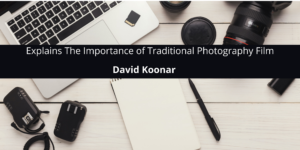David Koonar Explains The Importance of Traditional Photography Film


David Koonar Explains Why Traditional Photography Film is Still Worth It
Interested in photography and wondering if traditional film is worth your effort? David Koonar digs in.
When’s the last time you used traditional film? Unless you’re a professional photographer or serious hobbyist, you probably haven’t used traditional film all that often over the past few years. These days, just about everyone has a digital camera. Still, pro photographer David Koonar believes that traditional film is worth using in many circumstances.
“First, I think we need to move past the ‘which is better’ debate,” David Koonar suggests, “both digital and traditional cameras are great and excel in different circumstances. It’s not about one or the other but instead finding the best solution for a given situation.”
If you’re going to be taking hundreds of photos for a big event, digital cameras will often be the best choice simply because they’re easier to work with. Even if traditional film offers certain aesthetic benefits, digital film is much easier to use when a huge number of shots are required.
For more intimate events and circumstances, however, traditional film can really shine. While many filters and software programs try to emulate traditional film, it’s hard to beat the original.
“Traditional film is excellent when you’re working with natural light,” David Koonar points out. “For one, traditional film is often more forgiving. Further, it’s hard to replicate the authenticity of natural light on traditional film.”
Traditional film also excels at blending light and color. With a digital camera sensor, each photo can be broken down into tiny squares. These squares will typically be one color or another. While you can combine millions of these squares to make a picture, at the basic level, there’s still a hard separation.
Traditional film blends more smoothly than digital cameras can. This helps better blend light and color in a way that’s all but impossible with digital cameras.
“If I’m going into a photoshoot where color is especially important, natural film is very tempting,” David Koonar says. “I might use both digital and traditional film for a given shoot, but often the best shots come with traditional film.”
Traditional film also has a very pleasing grain, which provides texture and color for photos. Many digital filters and software programs try to replicate this grain, but so far, none have measured up to traditional film.
“You know traditional film when you see it,” David Koonar points out. “It’s pretty much impossible to replicate that natural grain.”
David Koonar Explains Why Digital Film is Great to Start With
Now you know that it’s hard to match the aesthetics of traditional film. So, does that mean you should ditch digital cameras? Absolutely not! Digital cameras are great in many situations and are especially helpful for beginners.
“With digital cameras, you can take thousands of shots without having to worry about film costs,” David Koonar says. “You can experiment and learn from your mistakes. I recommend that every aspiring photographer try traditional film, but you should still start with digital to get some practice.”
